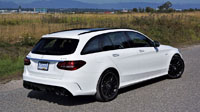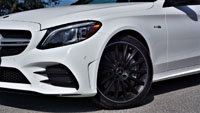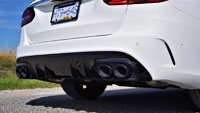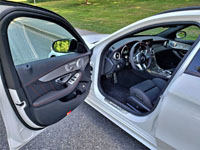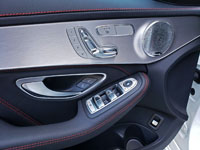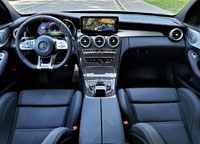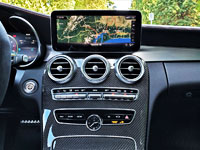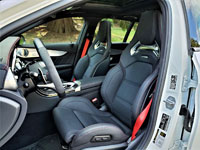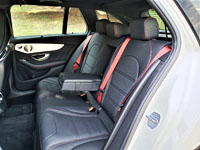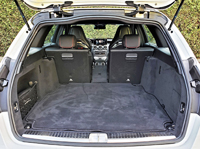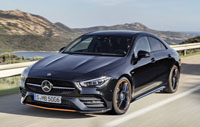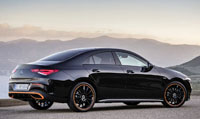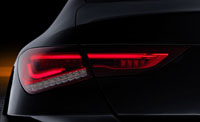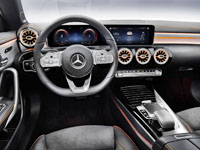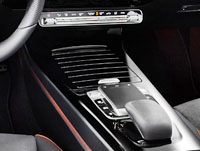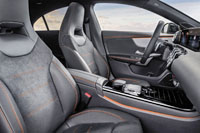
Few vehicles ever earn “icon” status. They’re either not around long enough, or their manufacturers change them so dramatically from their original purpose that only the name remains.
Case in point, Chevy’s new car-based Blazer family hauler compared to Ford’s go-anywhere Bronco. One is a complete departure from the arguably iconic truck-based original, whereas the other resurrects a beloved nameplate with new levels of on- and off-road prowess.

Land Rover has done something similar with its new Defender, yet due to radically departing from the beloved 1990-2016 first-generation Defender 90 and 110 models’ styling (which was based on the even more legendary 1948-1958 Series I, 1958-1961 Series II, 1961-1971 Series IIA, and 1971-1990 Series III) it runs the risk of losing the nameplate’s iconic status.
In fact, a British billionaire eager to cash in on Land Rover’s possible mistake is building a modernized version of the classic Defender 110 for those with deep pockets, dubbed the Ineos Grenadier (Ineos being the multinational British chemical company partly owned by said billionaire, Jim Ratcliffe). That the Grenadier was partly developed and is being produced by Magna Steyr in its Graz, Austria facility, yes, the same Magna Steyr that builds the Mercedes-Benz G-Class being tested here, is an interesting coincidence, but I digress. The more important point being made is that Mercedes’ G-Class never needed resurrecting. Like Jeep’s Wrangler, albeit at a much loftier price point, the G-wagon has remained true to its longstanding design and defined purpose from day one, endowing it with cult-like status.

The G-Class was thoroughly overhauled for the 2019 model year, this being the SUV’s second generation despite more than 40 years of production, so as you can likely imagine, changes to this 2020 model and the upcoming 2021 version are minimal. The same G 550 and sportier AMG G 63 trims remain available, but the more trail-specified 2017-2018 G 550 4×4 Squared, as well as the more pavement-performance focused 2016-2018 AMG G 65 haven’t been offered yet, nor for that matter has the awesome six-wheel version, therefore we’ll need to watch and wait to see what Mercedes has in store.
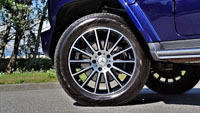
The 2019 exterior updates included plenty of new body panels, plus revised head and tail lamp designs (that aren’t too much of a departure from the original in shape and size), and lastly trim modifications all-round. The model’s squared-off, utilitarian body style remains fully intact, which is most important to the SUV’s myriad hardcore fans.
While I’m supposed to be an unbiased reporter, truth be told I’m also a fan of this chunky off-roader. In fact, I’m actually in the market for a diesel-powered four-door Geländewagen (or a left-hand drive, long-wheelbase Toyota Land Cruiser 70 Series diesel in decent shape), an earlier version more aligned with my budget restraints and less likely to cause tears when inevitably scratching it up off-road. Of course, if personal finances allowed me to keep the very G 550 in my possession for this weeklong test, I’d be more than ok with that too, as it’s as good as 4×4-capable SUVs get.
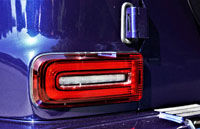
While first- to second-generation G-Class models won’t be immediately noticeable to casual onlookers, step inside and the differences are dramatic. The new model features a totally new dash design and higher level of refinement overall, including the brand’s usual jewel-like metalwork trim, and bevy of new digital interfaces that fully transform its human/machine operation. Your eyes will likely lock onto Mercedes’ new MBUX digital instrument cluster/infotainment touchscreen first, which incorporates dual 12.3-inch displays within one long, horizontal, glass-like surface.
The right-side display is a touchscreen, but can alternatively be controlled by switchgear on the lower centre console, while the main driver display can be modulated via an old Blackberry-style micro-pad on the left steering wheel spoke. Together, the seemingly singular interface is one of my industry favourites, not only in functionality, which is superb, but from a styling perspective as well.
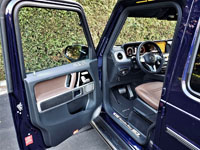
The majority of other interior switchgear is satin-silver-finished or made from knurled aluminum, resulting in a real sense of occasion, which while hardly new for Mercedes is a major improvement for the G-Class. Likewise, the drilled Burmester surround sound speaker grilles are some of the prettiest available anywhere, as are the deep, rich open-pore hardwood inlays that envelope the primary gauge cluster/infotainment binnacle, the surface of the lower console, and the trim around the doors’ armrests.
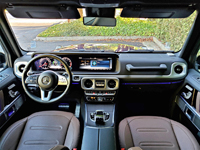
The G isn’t devoid of hard composites, but centre console side panels that don’t quite meet pricey expectations aren’t enough to complain about, particularly when the SUV’s door panel and seat upholstery leatherwork is so fine. My test model’s interior also featured beautiful chocolate brown details that contrasted its sensational blue exterior paint well.
Driver’s seat bolstering is more than adequate, as are the chair’s other powered adjustments, the only missing element being an adjustable thigh support extension. Still, its lower cushion cupped below my knees nicely enough, which, while possibly a problem for drivers on the short side, managed my five-foot-eight frame adequately. At least the SUV’s four-way powered lumbar support applied the right amount of pressure to the exact spot on my lower back requiring relief, as it should for most body types. Likewise, the G 550’s tilt and telescopic steering column provided plenty of reach, resulting in a near perfect driving position despite my short-torso, long-legged body.
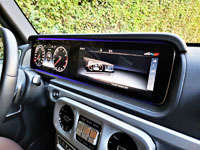
As part of the redesign, Mercedes increased rear seat legroom to allow taller passengers the ability to stretch out in comfort. What’s more, those back seats are nearly as supportive as the ones in front, other than the centre position that’s best left for smaller adults or kids.
All of this refinement is hardly inexpensive, with the base 2020 G 550 priced at $147,900 plus freight and fees, and the 2021 version starting at an even heftier $154,900. This said, our 2020 and 2021 Mercedes-Benz G-Class Canada Prices pages are currently reporting factory leasing and financing rates from zero-percent, which could go far in making a new G-Class more affordable. The zero-interest rate deal seems to apply to the $195,900 2020 G 63 AMG as well, plus the $211,900 2021 G 63 AMG, so it might make sense to buy this SUV on credit and invest the money otherwise spent (I’m guessing commodities are a good shot considering government promises of infrastructure builds, inflated currencies, runaway debt, market bubbles, etcetera, but in no way take my miscellaneous ramblings as investment advice).
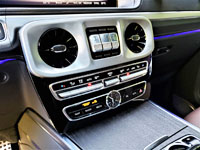
By the way, along with information about factory financing and leasing deals, CarCostCanada provides Canadian consumers with info about manufacturer rebates when available, plus dealer invoice pricing that could save you thousands. Find out more about how CarCostCanada’s very affordable membership can work for you, and remember to download our free smartphone app from the Apple Store or Google Play Store, so you can have all of this great information at your fingertips anytime, anywhere.
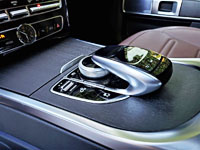
Anytime or anywhere in mind, the G 550 can pretty well get you everywhere in Canada, anytime of the year. There’s absolutely no need to expend more investment to buy aftermarket off-road components when at the wheel of this big Merc, as it can out-hustle most any other 4×4-capable SUV on the market. While I would’ve liked even more opportunities to shake the G-Class out on unpaved roads, I certainly enjoyed the number of instances I did so, and can attest to their greatness off the beaten path. I’ve waded them over rock-strewn hills, negotiated them around jagged canyon walls and between narrow treed trails, coaxed them through fast-paced rivers and muddy marshes, and even felt their tires slip when dipped into soft, sandy stretches of beach, so my desire to own one comes from experience. Just the same I didn’t want to risk damaging my G 550 test model’s stylish 14-spoke alloys on pavement-spec 275/50 Pirelli Scorpion Zero rubber, so I kept this example on the street.
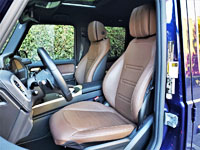
The G 550’s ride was sublime even with these lower-profile performance tires, which goes to show that car-based unibody designs don’t really improve ride quality, as much as at-the-limit handling. The G-Class’ frame is rigid after all, as is its body structure, while its significant suspension travel only aids ride compliance. Therefore, it made the ideal city companion, its suspension nearly eliminating the types of ruts and bridge expansion joints that intrude on the comfort levels of lesser SUVs, while its extreme height provides excellent visibility all around.
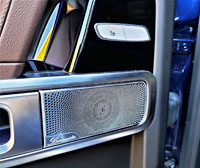
Those who spend more time on the open highway shouldn’t be wary of the G 550 either, as its ride continued to please and high-speed stability inspired confidence. I would’ve loved to have been towing an Airstream Flying Cloud in back to test its 7,000-lb rating (and given me more comfort than my tent), but I’m sure it can manage the load well, especially when factoring in its 2,650-kg (5,845-lb) curb weight.
Despite that heft, the G 550 performs fairly well when cornering, the previously noted Pirellis proving to be a good choice for everyday driving. I’ve previously driven the AMG-tuned G 63 on road and track, so the G 550’s abilities didn’t blow me away, but it certainly handles curves better than its blocky, brick-like shape alludes.
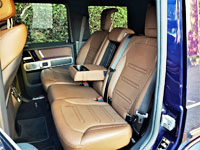
Braking is strong for such a big, heavy ute too, and while the G 550’s 416-horsepower 4.0-litre, twin-turbocharged V8 can’t send it from standstill to 100 km/h at the same 4.5-second rate as the 577-hp G 63, its 5.9 seconds for the same feat is nonetheless respectable, its 450 lb-ft of torque, quick-shifting eight-speed automatic, and standard four-wheel drive aiding the process perfectly, not to mention a very engaging Sport mode.
Engaging might not be the best word for it, mind you. In fact, I found the G 550’s Sport mode a bit too aggressive for my tastes, bordering on uncomfortable. It helps the big SUV shoot off the line with aggression, but the sheer force of it all snapped my head back into the seat’s pillowy headrests too often for comfort’s sake, but only when trying to move off the line in particularly quick fashion. When first feathering the throttle, as I usually drive, and then shortly thereafter dipping into it for stronger acceleration, it worked fine. I wish Mercedes’ had integrated a smoother start into the SUV’s firmware, but the requirement to use skill in order to get the most out of it was kind of nice too. All said, at the end of such tests I just left it in Eco mode for blissfully smooth performance and better economy.

Fuel sipping in mind, no amount of technology this side of turbo-diesel power (how I miss those days) can make this brute eco-friendly, with Transport Canada’s fuel economy rating measuring 18.0 L/100km city, 14.1 highway, and 16.3 combined. It’s not worse than some other full-size, V8-powered utilities, nor does it thirst for pricier premium fuel, but this might be an issue for those with a greener conscious.
Speaking of pragmatic issues, the G-Class is a bit short on cargo capacity when comparing to some of those full-size SUV rivals just noted, especially American branded alternatives such as the Cadillac Escalade and Lincoln Navigator. Then again, the G fares better when measuring up to similarly equipped European luxury utes, with the 1,079-litre (38.1 cu-ft) dedicated cargo area a sizeable 178 litres (6.3 cu ft) greater than the full-size Range Rover’s maximum luggage volume. Interestingly, both luxury SUV’s load-carrying capacity is an identical 1,942 litres (68.6 cu ft), which is ample in my books.
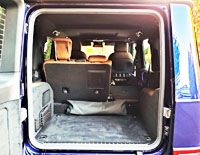
After my week with Mercedes’ top-line SUV, I can’t complain. Certainly, I would’ve liked a larger sunroof or, even better, something along the lines of the Jeep Wrangler Unlimited’s new Sky One-Touch Power Top that turns the entire rooftop into open air while still maintaining solid sides and back with windows, but this might weaken the G’s body structure and limit its 4×4 prowess. I also would’ve liked a wireless phone charger, and would have one installed if this was my personal ride.
Hopefully my next G-Class tester will be more suitable to wilderness forays, possibly as an updated gen-2 G 550 4×4²? Previous examples included portal axles like Mercedes’ fabulously capable Unimog, but in just about every other respect I was thoroughly impressed with this well-made luxury utility, and glad Mercedes stayed true to this model’s iconic 4×4 heritage. To me, the G-Glass is the ultimate on-road, off-road compromise, and I’d own one if money allowed.
Story and photos by Trevor Hofmann


